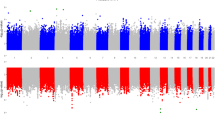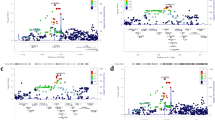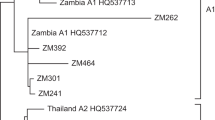Abstract
Cervical carcinoma is now known to be associated with human papillomaviruses (HPV), but the evidence for a link with specific HLA loci is controversial. The role of genetic variation at the HLA class II loci and among HPV types in cervical carcinoma was investigated by PCR DNA amplification and oligonucleotide probe typing of paraffin–embedded invasive cervical cancer tissue from Hispanic patients and of cervical swabs from Hispanic controls. Certain HLA class II haplotypes (such as DRB1*1501–DQB1*0602) were associated significantly, while DR13 haplotypes were negatively associated with cervical carcinoma. These associations are HPV16–type specific. These results suggest that specific HLA class II haplotypes may influence the immune response to specific HPV–encoded epitopes and affect the risk of cervical neoplasia.
This is a preview of subscription content, access via your institution
Access options
Subscribe to this journal
Receive 12 print issues and online access
$209.00 per year
only $17.42 per issue
Buy this article
- Purchase on Springer Link
- Instant access to full article PDF
Prices may be subject to local taxes which are calculated during checkout
Similar content being viewed by others
References
Schiffman, M.H. et al. Epidemiologic evidence showing that human papillomavirus infection causes most cervical intraepithelial neoplasia. J. natn. Cancer Inst. 85, 958–964 (1993).
Koutsky, L.A. et al. A cohort study of the risk of cervical intraepithelial neoplasia grade 2 or 3 in relation to papillomavirus infection. New Engl. J. Med. 327, 1272–1278 (1992).
Epidemiology of Cervical Cancer and Human Papillomavirus (eds Muñoz, N., Bosch, F.X., Shah, K.V. & Meheus, A.) (IARC, Lyon, 1992).
Carmichael, J.A. & Maskens, P.D. Cervical dysplasia and human papillomavirus. Am. J. obstet. Gynecol. 162, 645–651 (1990).
Lorincz, A.T. et al. Temporal associations of human papillomavirus infection with cervical cytologic abnormalities. Am. J. obstet. Gynecol. 162, 645–651 (1990).
Kiviat, N.B. et al. Prevalence of genital papillomavirus infection among women attending a college student health clinic or a sexuaxlly transmitted disease clinic. J. infect. Dis. 159, 293–302 (1989).
Bauer, H.M. et al. Genital human papillomavirus infection in female university students as determined by a PCR-based method. J. Am. med. Assn. 265, 472–477 (1991).
Brinton, L.A. Epidemiology of cervical cancer — overview, in Epidemiology of Cervical Cancer and Human Papillomavirus (eds Munoz, N., Bosch, F.X., Shah, K.V. & Meheus A.) 3–23 (IARC, Lyon, 1992).
Han, R., Breitburd, F., Marche, P.N. & Orth, G. Linkage of regression and malignant conversion of rabbit viral papillomas to MHC class II genes. Nature 356, 66–68 (1992).
Nepom, G.T. & Erlich, H.A. MHC class-ll molecules and autoimmunity. Annu. Rev. Immunol. 9, 493–525 (1991).
Hill, A.V.S. et al. Common west african HLA antigens are associated with protection from severe malaria. Nature 352, 595–600 (1991).
Hill, A.V.S. et al. Molecular analysis of the association of HLA-B53 and resistance to severe malaria. Nature 360, 434–439 (1992).
Lu, S. et al. Linkage of a nasopharyngeal carcinoma susceptibility locus to the HLA region. Nature 346, 470–471 (1990).
Amiel, J. Study of the leukocyte phenotypes in Hodgkin's disease, in Histocompatibility Testing 1967 (ed. Terasaki, P.I.) 79 (Munksgaard, Copenhagen, 1967).
Klitz, W., Aldrich, C.A., Fildes, N., Horning, S.S. & Begovich, A.B. Localization of predisposition to Hodgkin's disease in the HLA class II region. Am. J. hum. Genet.(in the press).
Wank, R. & Thomssen, C. High risk of squamous cell carcinoma of the cervix for women with HLA-DQw3. Nature 352, 723–725 (1991).
Helland, A., Børresen, A.L., Kærn, S., Rønningen, K.S. & Thorsby, E. HLA antigens and cervical carcinoma. Nature 356, 23 (1992).
David, A.L. et al. HLA-DQB1*03 and cervical intraepithelial neoplasia type III. Lancet 340, 52 (1992).
Glew, S.S., Stern, P.L., Davidson, J.A. & Dyer, P.A. HLA antigens and cervical carcinoma. Nature 356, 22 (1992).
Vandenvelde, C., De Foor, M. & Van Beers, D. HLA-DQB1*03 and cervical intraepithelial neoplasia grades I–III. Lancet 341, 442–443 (1993).
Glew, S.S. et al. Lack of association of HLA polymorphism with human papillomavirus-related cervical cancer. Human Immunol. 37, 157–164 (1993).
Lorincz, A.T. et al. Human papillomavirus infection of the cervix: relative risk associations of 15 common anogenital types. Obstet. Gynecol. 79, 328–337 (1992).
Saiki, R.K., Bugawan, T.L., Horn, G.T., Mullis, K.B. & Erlich, H.A. Analysis of enzymatically amplified β-globin and HLA-DQα DNA with allele-specific oligonucleotide probes. Nature 324, 163–166 (1986).
Scharf, S.J., Griffith, R.L. & Erlich, H.A. Rapid typing of DNA sequence polymorphism at the HLA-DRB1 locus using the polymerase chain reaction and non-radioactive oligonucleotide probes. Human Immunol. 32, 190–201 (1991).
Bugawan, T.L. & Erlich, H.A. Rapid typing of the HLA-DQB1 DNA polymorphism using non-radioactive oligonucleotide probes and amplified DNA. Immunogenetics 33, 163–170 (1991).
Manos, M.M. et al. Use of polymerase chain reaction amplification for the detection of genital human papillomaviruses, in Molecular diagnostics of human cancer:, cancer Cells (eds Furth, M. & Greaves, M.) Vol. 7, 209–214 (Cold Spring Harbor Press, New York, 1989).
Bauer, H., Greer, C. & Manos, M. Determination of genital human papillomavirus infection by consensus PCR amplification, in Diagnostic Molecular Pathology: A Practical Approach. (eds Herrington, C.S. & McGee, J.O'D.) 131–152 (Oxford University Press, Oxford, 1992).
Becker, T.M., Wheeler, C.M., Key, C.R. & Samet, S.M. Cervical cancer incidence and mortality in New Mexico's Hispanics, American Indians, and non-Hispanic whites. West. J. Med. 156, 376–379 (1992).
Peters, R.K., Thomas, D., Hagan, D.G., Mack, T.M. & Henderson, B.E. Risk factors for invasive cervical cancer among Latinas and non-Latinas in Los Angeles County. J. natn. Cancer Inst. 77, 1063–1077.
Reeves, W.C. et al. Case-control study of cervical cancer in Herrera Province, Republic of Panama. Int. J. Cancer 36, 55–60 (1985).
Schiffman, M.H. Validation of hybridization assays: correlation of filter in situ, dot blot and PCR with Southern blot, in Epidemiology of Cervical Cancer and Human Papillomavirus (eds Muñoz, N., Bosch, F.X., Shah, K.V. and Meheus, A.) 169–179 (IARC, Lyon, 1992).
Wheeler, C.M. et al. Determinants of genital human papillomavirus infection among cytologically normal women attending the University of New Mexico student health center. J. sex. trans. Dis. 120, 286–289 (1993).
Begovich, A.B. et al. Polymorphism, recombination and linkage disequilibrium within the HLA class II region. J. Immunol. 148, 249–258 (1991).
Erlich, H.A. et al. HLA class II alleles and susceptibility and resistance to insulin dependent diabetes mellitus in Mexican-American families. Nature Genet. 3, 358–364 (1993).
Sokal, R.R. & Rohlf, F.J. Biometry: The Principals and Practice of Statistics in Biological Research 2nd edn (W.H. Freeman, San Francisco, 1981).
Wank, R., Schendel, D.J. & Thomssen, C. HLA antigens and cervical carcinoma. Nature 356, 22–23 (1992).
Werness, B.A., Levine, A.J. & Howley, P.M. Associations of human papillomavirus types 16 and 18 E6 proteins with p53. Science 248, 76–79 (1990).
Dyson, N., Howley, P.M., Münger, K. & Harlow, E. The human papilloma virus-16 E7 oncoprotein is able to bind to the retinoblastoma gene product. Science 243, 934–937 (1989).
Chen, L., Thomas, E.K., Hu, S.L., Hellström, I. & Hellström, K.E. Human papillomavirus type 16 nucleoprotein E7 is a tumor rejection antigen. Proc. natn. Acad. Sci. U.S.A. 88, 110–114 (1991).
Danos, O., Giri, I., Thierry, F. & Yaniv, M. Papillomavirus genomes: sequences and consequences. J. invest. Derm. 83, 73–113 (1984).
DeVilliers, E.-M. Heterogeneity of the human papillomavirus group. J. Virol. 63, 4898–4903 (1989).
Chan, S.-Y. et al. Phylogenetic analysis of 48 papillomavirus types and 28 subtypes and variants: a showcase for the molecular evolution of DNA viruses. J. Virol. 66, 5714–5725 (1992).
Strang, G. et al. Human T cell responses to human papillomavirus type 16 L1 and E6 synthetic peptides: identification of T cell determinants, HLA-DR restriction and virus type specificity. J. gen. Virol. 71, 423–431 (1990).
Apple, R.J. & Erlich, H.A. Two new HLA DRB1 alleles found in African Americans: implications for balancing selection at positions 57 and 86. Tissue Antigens 40, 69–74 (1992).
Author information
Authors and Affiliations
Rights and permissions
About this article
Cite this article
Apple, R., Erlich, H., Klitz, W. et al. HLA DR–DQ associations with cervical carcinoma show papillomavirus–type specificity. Nat Genet 6, 157–162 (1994). https://doi.org/10.1038/ng0294-157
Received:
Accepted:
Issue Date:
DOI: https://doi.org/10.1038/ng0294-157
This article is cited by
-
Role of polycyclic aromatic hydrocarbons as a co-factor in human papillomavirus-mediated carcinogenesis
BMC Cancer (2019)
-
Persistent HPV16/18 infection in Indian women with the A-allele (rs6457617) of HLA-DQB1 and T-allele (rs16944) of IL-1β −511 is associated with development of cervical carcinoma
Cancer Immunology, Immunotherapy (2015)
-
Copy number variation of the antimicrobial-gene, defensin beta 4, is associated with susceptibility to cervical cancer
Journal of Human Genetics (2013)
-
Association of p21 SNPs and risk of cervical cancer among Chinese women
BMC Cancer (2012)
-
HLA class-II allele frequencies in Turkish breast cancer patients
Medical Oncology (2012)



